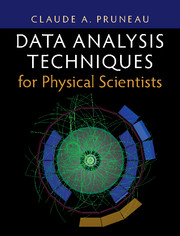Preface
Published online by Cambridge University Press: 24 October 2017
Summary
Physics students typically take a wide range of advanced classes in mechanics, electromagnetism, quantum mechanics, thermodynamics, and statistical mechanics, but sadly, receive only limited formal training in data analysis techniques. Most students in experimental physics indeed end up gleaning the required material by reading parts of a plurality of books and scientific articles. They typically end up knowing a lot about one particular analysis technique but relatively little about others. Paradoxically, modern experiments in particle and nuclear physics enable an amazingly wide range of very sophisticated measurements based on diverse analytical techniques. The end result is that beginning students may have a rather limited understanding of the many papers they become coauthors of by virtue of being members of a large scientific collaboration. After twenty years of teaching “physics” and carrying out research in heavy-ion physics, I figured I should make an effort to remedy this situation by creating a book that covers all the basic tools required in the data analysis of experiments at RHIC, the LHC, and other large experimental facilities.
This was a fairly ambitious project given that the range of techniques employed in today's experiments is actually quite large and rather sophisticated. In the interest of full disclosure, I should state that the scope of the project changed several times, at times growing and at others shrinking. Eventually, I decided for a book in three parts covering (I) foundational concepts in probability and statistics, (II) basic and commonly used advanced measurement techniques, and (III) introductory techniques in Monte Carlo simulations targeted, mostly, toward the analysis and interpretation of experimental data. As such, it became impossible to present detailed descriptions of detector technologies or the physical principles they are based on. But as it turns out, high-quality data analyses are possible even if one is not familiar with the many technical details involved in the design or construction of detectors. Detector attributes relevant for data analyses can in general be reduced to a statement of a few essential properties, and it is thus possible to carry out quality analyses without a full knowledge of all aspects of a detector's design and operation. I have thus opted to leave out detailed descriptions of detector technologies as well as particle interactions with matter and focus the discussion on some representative and illustrative examples of data calibration and analyses.
- Type
- Chapter
- Information
- Data Analysis Techniques for Physical Scientists , pp. xi - xiiPublisher: Cambridge University PressPrint publication year: 2017

